
Mainz is the capital and largest city of the German state of Rhineland-Palatinate, and with around 223,000 inhabitants, it is Germany's 35th-largest city. It lies in the Rhine-Main Metropolitan Region—Germany's second-largest metropolitan region after Rhine-Ruhr—which also encompasses the cities of Frankfurt am Main, Wiesbaden, Darmstadt, Offenbach am Main, and Hanau.

Rhineland-Palatinate is a western state of Germany. It covers 19,846 km2 (7,663 sq mi) and has about 4.05 million residents. It is the ninth largest and sixth most populous of the sixteen states. Mainz is the capital and largest city. Other cities are Ludwigshafen am Rhein, Koblenz, Trier, Kaiserslautern, Worms, and Neuwied. It is bordered by North Rhine-Westphalia, Saarland, Baden-Württemberg and Hesse and by France, Luxembourg and Belgium.

Trier, formerly and traditionally known in English as Trèves and Triers, is a city on the banks of the Moselle in Germany. It lies in a valley between low vine-covered hills of red sandstone in the west of the state of Rhineland-Palatinate, near the border with Luxembourg and within the important Moselle wine region.
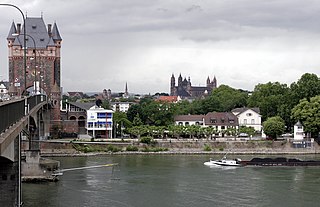
Worms is a city in Rhineland-Palatinate, Germany, situated on the Upper Rhine about 60 km (40 mi) south-southwest of Frankfurt am Main. It had about 84,646 inhabitants as of 2022.

Wiesbaden is the capital of the German state of Hesse, and the second-largest Hessian city after Frankfurt am Main. With around 283,000 inhabitants, it is Germany's 24th-largest city. Wiesbaden forms a conurbation with a population of around 500,000 with the neighbouring city of Mainz. This conurbation is in turn embedded in the Rhine-Main Metropolitan Region—Germany's second-largest metropolitan region after Rhine-Ruhr—which also includes the nearby cities of Frankfurt am Main, Darmstadt, Offenbach am Main, and Hanau, and has a combined population exceeding 5.8 million.

Heidelberg is a city in the German state of Baden-Württemberg, situated on the river Neckar in south-west Germany. As of the 2016 census, its population was 159,914, of which roughly a quarter consisted of students.

The Rheinwiesenlager were a group of 19 concentration camps built in the Allied-occupied part of Germany by the U.S. Army to hold captured German soldiers at the close of the Second World War. Officially named Prisoner of War Temporary Enclosures (PWTE), they held between one and almost two million surrendered Wehrmacht personnel from April until September 1945.

Mittelbau-Dora was a Nazi concentration camp located near Nordhausen in Thuringia, Germany. It was established in late summer 1943 as a subcamp of Buchenwald concentration camp, supplying slave labour from many Eastern countries occupied by Germany, for extending the nearby tunnels in the Kohnstein and for manufacturing the V-2 rocket and the V-1 flying bomb. In the summer of 1944, Mittelbau became an independent concentration camp with numerous subcamps of its own. In 1945, most of the surviving inmates were sent on death marches or crammed in trains of box-cars by the SS. On 11 April 1945, US troops freed the remaining prisoners.

Neustadt an der Weinstraße is a town in Rhineland-Palatinate, Germany. With 53,300 inhabitants as of 2020, it is the largest town called Neustadt.

Hartenberg-Münchfeld is a borough of the Rhineland-Palatinate state capital Mainz, Germany.

Mainz-Kastel is a district of the city Wiesbaden, which is the capital of the German state Hesse in western Germany.
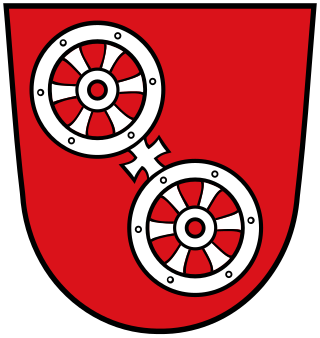
The Wheel of Mainz or Mainzer Rad, in German, was the coat of arms of the Archbishopric of Mainz and thus also of the Electorate of Mainz (Kurmainz), in Rhineland-Palatinate, Germany. It consists of a silver wheel with six spokes on a red background. The wheel can also be found in stonemasons' carvings and similar objects. Currently, the City of Mainz uses a double wheel connected by a silver cross.

Hinzert concentration camp was a concentration camp in Nazi Germany, in what is now Rhineland-Palatinate, 30 kilometres (19 mi) from the border with Luxembourg. Between 1939 and 1945, 13,600 political prisoners between the ages of 13 and 80 were imprisoned at Hinzert. Many were in transit towards larger concentration camps where most would be killed. However, many prisoners were executed at Hinzert. The camp was administered, run, and guarded mainly by the SS, who, according to survivors, were notorious for their brutality and viciousness.
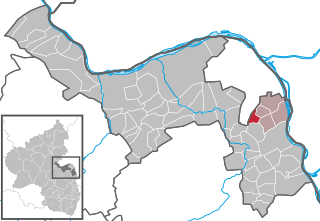
Harxheim is an Ortsgemeinde – a municipality belonging to a Verbandsgemeinde, a kind of collective municipality – in the Mainz-Bingen district in Rhineland-Palatinate, Germany.
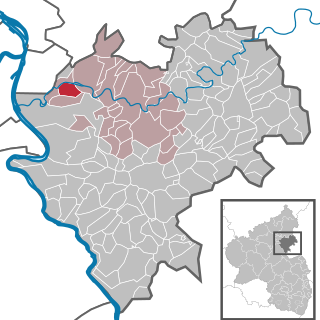
Nievern is a municipality in the district of Rhein-Lahn, in Rhineland-Palatinate, in western Germany. It belongs to the association community of Bad Ems-Nassau.
Mainz-Drais (Drais) is a borough in the western part of Mainz. The village was suburbanised by the City of Mainz in 1969, and is now its smallest subdivision, with just over 3,000 permanent residents.
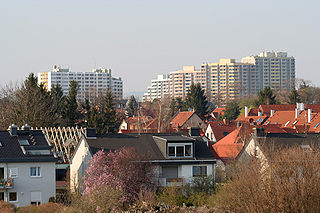
Gonsenheim is a borough in the northwest corner of Mainz, Germany. With about 25,000 inhabitants, it is the second-most populated borough of Mainz, before Oberstadt and after Neustadt.

Wilhelm Simon was a German SS-Hauptscharführer and concentration camp functionary. During World War II he held various administrative posts at Buchenwald and Mittelbau-Dora. He was convicted of war crimes by the United States in 1947.

Ursula Groden-Kranich is a German politician of the Christian Democratic Union of Germany (CDU) who served as a member of the Bundestag from 2013 to 2021, representing the constituency of Mainz. She is also a member of Mainz City Council and was the local representative for Mainz-Hechtsheim between 2004 and 2014.
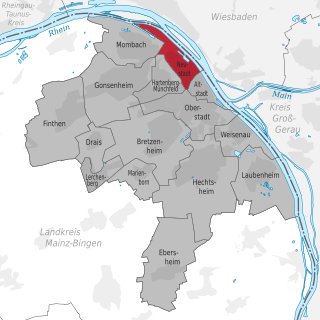
Neustadt, with 29,982 inhabitants, is a borough in the north of Mainz, Germany. It is located northwest of the old town, beyond the wide Kaiserstrasse. Characteristic are the great number of squares and traffic-calmed streets, the pubs and cafés, the small shops, the Turkish shops and smaller craft businesses. The Neustadt lives from its mixture of old-established Mainzers, newcomers, immigrants and young students. Neustadt is the most densely populated district in Mainz.





















